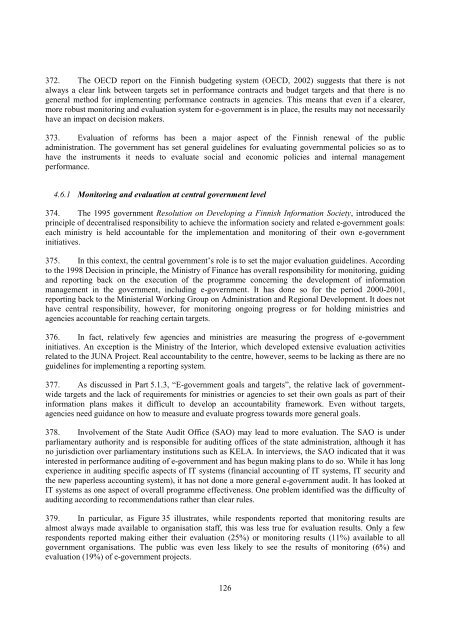e-GOVERNMENT IN FINLAND - ePractice.eu
e-GOVERNMENT IN FINLAND - ePractice.eu
e-GOVERNMENT IN FINLAND - ePractice.eu
Create successful ePaper yourself
Turn your PDF publications into a flip-book with our unique Google optimized e-Paper software.
372. The OECD report on the Finnish budgeting system (OECD, 2002) suggests that there is not<br />
always a clear link between targets set in performance contracts and budget targets and that there is no<br />
general method for implementing performance contracts in agencies. This means that even if a clearer,<br />
more robust monitoring and evaluation system for e-government is in place, the results may not necessarily<br />
have an impact on decision makers.<br />
373. Evaluation of reforms has been a major aspect of the Finnish renewal of the public<br />
administration. The government has set general guidelines for evaluating governmental policies so as to<br />
have the instruments it needs to evaluate social and economic policies and internal management<br />
performance.<br />
4.6.1 Monitoring and evaluation at central government level<br />
374. The 1995 government Resolution on Developing a Finnish Information Society, introduced the<br />
principle of decentralised responsibility to achieve the information society and related e-government goals:<br />
each ministry is held accountable for the implementation and monitoring of their own e-government<br />
initiatives.<br />
375. In this context, the central government’s role is to set the major evaluation guidelines. According<br />
to the 1998 Decision in principle, the Ministry of Finance has overall responsibility for monitoring, guiding<br />
and reporting back on the execution of the programme concerning the development of information<br />
management in the government, including e-government. It has done so for the period 2000-2001,<br />
reporting back to the Ministerial Working Group on Administration and Regional Development. It does not<br />
have central responsibility, however, for monitoring ongoing progress or for holding ministries and<br />
agencies accountable for reaching certain targets.<br />
376. In fact, relatively few agencies and ministries are measuring the progress of e-government<br />
initiatives. An exception is the Ministry of the Interior, which developed extensive evaluation activities<br />
related to the JUNA Project. Real accountability to the centre, however, seems to be lacking as there are no<br />
guidelines for implementing a reporting system.<br />
377. As discussed in Part 5.1.3, “E-government goals and targets”, the relative lack of governmentwide<br />
targets and the lack of requirements for ministries or agencies to set their own goals as part of their<br />
information plans makes it difficult to develop an accountability framework. Even without targets,<br />
agencies need guidance on how to measure and evaluate progress towards more general goals.<br />
378. Involvement of the State Audit Office (SAO) may lead to more evaluation. The SAO is under<br />
parliamentary authority and is responsible for auditing offices of the state administration, although it has<br />
no jurisdiction over parliamentary institutions such as KELA. In interviews, the SAO indicated that it was<br />
interested in performance auditing of e-government and has begun making plans to do so. While it has long<br />
experience in auditing specific aspects of IT systems (financial accounting of IT systems, IT security and<br />
the new paperless accounting system), it has not done a more general e-government audit. It has looked at<br />
IT systems as one aspect of overall programme effectiveness. One problem identified was the difficulty of<br />
auditing according to recommendations rather than clear rules.<br />
379. In particular, as Figure 35 illustrates, while respondents reported that monitoring results are<br />
almost always made available to organisation staff, this was less true for evaluation results. Only a few<br />
respondents reported making either their evaluation (25%) or monitoring results (11%) available to all<br />
government organisations. The public was even less likely to see the results of monitoring (6%) and<br />
evaluation (19%) of e-government projects.<br />
126
















